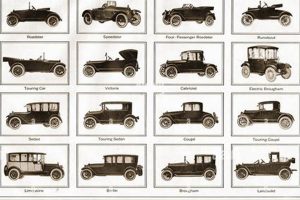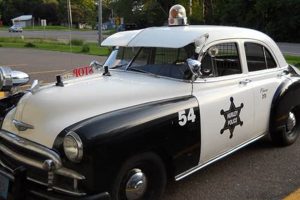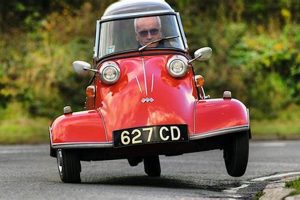These miniature racing vehicles, powered by electric motors and guided by a slot in the track, represent a tangible connection to a bygone era of hobbyist enthusiasm. Examples include models produced by companies such as Aurora, Strombecker, and Cox during the 1960s and 1970s, reflecting a range of designs and scales.
The appeal of these items extends beyond mere nostalgia. They provide a historical lens through which to examine the evolution of manufacturing techniques, design aesthetics, and popular culture. The preservation and restoration of these collectibles contributes to the understanding of a significant period in toy and hobby history, offering insights into the social and economic conditions that fueled their popularity.
The following sections will delve into specific aspects of collecting, restoring, and racing these iconic models, providing a comprehensive overview for enthusiasts and those interested in learning more about this engaging hobby.
Collecting and Preserving Collectible Racing Vehicles
Acquiring and maintaining these historical artifacts necessitates careful consideration to ensure their value and longevity.
Tip 1: Research Before Purchase: Prior to acquiring any specimen, conduct thorough research regarding its manufacturer, model, scale, and variations. This knowledge aids in verifying authenticity and assessing its market value. Consult reputable guides, online forums, and collector communities.
Tip 2: Assess Condition Carefully: Scrutinize the item’s condition meticulously. Look for signs of damage, wear, or alterations. Original paint, intact parts, and functioning motors significantly enhance value. Document any imperfections.
Tip 3: Prioritize Original Packaging: When available, original packaging enhances the collectible’s worth substantially. Packaging should be preserved carefully, protected from moisture, sunlight, and physical damage.
Tip 4: Implement Proper Storage: Store the models in a controlled environment, away from direct sunlight, extreme temperatures, and humidity. Display cases or acid-free storage boxes are recommended.
Tip 5: Document the Collection: Maintain a detailed inventory of the collection, including photographs, descriptions, purchase dates, and acquisition costs. This documentation proves invaluable for insurance purposes and estate planning.
Tip 6: Consider Professional Restoration: If restoration is necessary, engage qualified professionals with experience in restoring these specific models. Amateur repairs can diminish the value and integrity of the artifact.
Tip 7: Insure the Collection: Obtain adequate insurance coverage to protect against loss, damage, or theft. Consult with an insurance provider specializing in collectibles.
Adhering to these guidelines will safeguard the investment and ensure the preservation of these miniature relics for future generations.
The subsequent section will explore the competitive aspect of racing these restored and preserved models.
1. Rarity
Rarity is a primary driver of value and desirability within the sphere of collectible miniature racing vehicles. Scarcity, dictated by production volume, historical events, or geographical distribution, elevates certain models above others, creating intense competition among enthusiasts and investors.
- Limited Production Runs
Models produced in small quantities due to limited-time promotions, factory errors, or specific market demands acquire significant rarity. For example, a specific paint variant of a Cox Cheetah, produced for only a short period, would be considerably more valuable than a standard production color. The fewer examples that exist, the greater the demand and, consequently, the higher the price.
- Discontinued Models and Manufacturers
When a company ceases operations or discontinues a particular model line, the remaining examples automatically gain a degree of rarity. A Strombecker model from the 1960s, a company no longer in existence, is inherently scarcer than a comparable item from a currently operating manufacturer. The historical significance of the brand adds to the collectibility.
- Prototypes and Test Shots
Pre-production prototypes and test shots represent the pinnacle of rarity. These models, often handmade or produced in extremely limited numbers for testing purposes, provide a unique glimpse into the manufacturing process. A prototype Aurora G-Plus chassis, for instance, would be exceedingly rare and highly sought after by serious collectors.
- Special Editions and Commemorative Releases
Models released as special editions to commemorate events or celebrate anniversaries often have restricted production numbers, increasing their rarity over time. A commemorative release celebrating a specific racing event, like a Daytona 500 edition, becomes a tangible piece of history, its value augmented by its limited availability.
In summary, rarity, whether resulting from limited production, historical circumstances, or unique manufacturing anomalies, directly influences the value and desirability of collectible miniature racing vehicles, making it a critical factor for collectors and investors alike. The interplay of these elements determines which models achieve iconic status and command premium prices within the marketplace.
2. Condition
The condition of a miniature racing vehicle significantly dictates its value and collectibility. Preservation of original components and minimization of wear are crucial determinants for enthusiasts.
- Paint and Decals
Original paint and decals are paramount. Fading, scratches, or aftermarket paint jobs detract substantially from value. Factory-applied decals, if intact and untarnished, are highly desirable. A model retaining its original paint color and crisp decals is considered superior to a repainted or decal-modified example.
- Mechanical Functionality
Operational motors, undamaged gears, and properly functioning electrical components are essential. A model with a seized motor or broken gears has diminished value unless those parts can be replaced with correct, original components. Proper lubrication and careful handling contribute to maintaining mechanical condition.
- Completeness of Parts
The presence of all original parts, including wheels, tires, guide shoes, and body components, significantly impacts value. Missing or replaced parts negatively affect the item’s authenticity and desirability. A fully complete model, retaining all original factory components, is highly prized.
- Structural Integrity
The absence of cracks, breaks, or warping in the chassis or body is critical. Structural damage compromises both the aesthetic appeal and the functionality of the vehicle. Models exhibiting structural integrity command higher prices and are more readily accepted into collections.
In summary, the cumulative effect of these condition-related facets defines the overall value and desirability of these miniature racing vehicles. Collectors prioritize models that exhibit excellent condition, preserving their historical and aesthetic integrity.
3. Originality
Originality, in the context of these miniature racing vehicles, refers to the extent to which a specimen retains its factory-issued components, finishes, and configurations. It is a pivotal factor in determining collectibility and market value, often outweighing even rarity in certain circumstances.
- Factory Paint and Decals
The presence of original factory-applied paint and decals is a cornerstone of originality. Repainted bodies or reproduction decals immediately diminish value, even if expertly applied. Factory finishes demonstrate the model’s historical accuracy and production methods. For instance, an unrestored Aurora Thunderjet 500 retaining its original iridescent paint finish commands a premium over a repainted example, irrespective of the repaint’s quality.
- Matching Chassis and Body
A model’s originality is dependent upon having its original chassis and body paired together as they left the factory. Swapping bodies or chassis between different models or even different versions of the same model compromises originality. The correct chassis for a particular body style is crucial; a Cox Cheetah body on a Chaparral chassis negates the vehicle’s original configuration.
- Correct Motor and Running Gear
The presence of the factory-installed motor and running gear is paramount. Motors were often specific to a particular model or release, and replacing these components with aftermarket parts or incorrect motors reduces originality. Original tires, gears, and axles, free from modification, further enhance the item’s value. A Mabuchi FT16D motor in an early Tyco Pro is a significant indicator of originality.
- Unmodified Parts and Components
Originality dictates that parts and components remain free from modification. Drilling, cutting, or altering any part of the vehicle, whether for performance enhancement or aesthetic reasons, detracts from its original state. For example, if someone has modified a vintage Monogram model with modern tires it is no longer original.
These factors collectively contribute to the assessment of originality. An unrestored specimen retaining all its factory-issued components, finishes, and configurations represents the highest degree of originality and, consequently, commands a significant premium within the collector market. Deviations from this standard, however minor, impact the item’s value and historical significance.
4. Manufacturer
The manufacturer is a primary determinant of value, collectibility, and historical significance for these vintage miniature racing vehicles. The origin of a model directly influences its desirability among collectors, its representation of technological advancements, and its reflection of the cultural trends of its era. The reputation, innovation, and product line of a particular manufacturer establish a framework for assessing individual models.
For instance, models produced by Aurora, particularly their Thunderjet 500 and Vibrator lines, represent the mass-market appeal of the hobby during the 1960s and 1970s. Conversely, vehicles manufactured by Cox, renowned for their high-performance engines and realistic designs, appeal to a different segment of enthusiasts. Strombecker models, characterized by their robust construction and scale accuracy, offer a distinct perspective on the hobby’s early years. Each manufacturer embodies a unique approach to design, engineering, and marketing, shaping the overall landscape of these collectible items. Understanding the manufacturer’s history, product range, and technological innovations is crucial for assessing the historical and monetary value of specific models.
Ultimately, the manufacturer serves as a critical filter through which collectors and enthusiasts evaluate the importance and desirability of individual specimens. Recognizing the manufacturer’s influence allows for a deeper appreciation of the historical context, technological achievements, and cultural significance embodied by vintage slot cars. This understanding informs collecting strategies, restoration efforts, and the preservation of these artifacts for future generations.
5. Scale
Scale denotes the proportional relationship between a miniature racing vehicle and its real-world counterpart. For vintage models, scale dictates compatibility with tracks, other vehicles, and available replacement parts. Common scales include 1/24, 1/32, and HO (approximately 1/64), each influencing the level of detail and the space required for racing. The selection of a particular scale significantly affects the aesthetic presentation and operational characteristics of a collection.
For example, a 1/24 scale model offers a larger canvas for intricate detailing, enabling manufacturers to replicate fine features of the original automobile. Conversely, HO scale models, due to their smaller size, allow for more elaborate track layouts within a limited space. The choice of scale also impacts racing dynamics; larger scale vehicles often exhibit greater stability and traction, while smaller scale models can achieve higher speeds on appropriately designed tracks. Therefore, understanding scale is critical for both collectors and racers.
Scale not only dictates physical size but also influences the availability of replacement parts and aftermarket accessories. Certain scales, particularly 1/32, benefit from a broader range of aftermarket support, facilitating restoration and performance enhancement. Discrepancies in scale can lead to incompatibility issues and hinder the integration of different models within a single collection or racing environment. Accordingly, the careful consideration of scale is paramount for maintaining a cohesive and functional assortment of these historical artifacts.
6. Performance
The performance characteristics of vintage slot cars significantly influence their desirability and historical relevance. Functionality, specifically the vehicle’s ability to operate as intended, reflects the quality of its original design and the effectiveness of subsequent preservation efforts. A vintage model that exhibits near-original performance capabilities provides a tangible connection to the technological achievements and recreational pursuits of its era. For example, a fully restored Cox Cheetah, capable of achieving speeds comparable to its original specifications, demonstrates the engineering prowess of its manufacturer and enhances its appeal among collectors.
Modifications to enhance performance were a common practice during the heyday of slot car racing. Alterations to motors, gears, and tires sought to optimize speed and handling. While modifications often improved performance, they also detract from the vehicle’s originality, creating a dichotomy between functional enhancement and historical preservation. Collectors must weigh the benefits of improved performance against the loss of original components and configurations. Contemporary performance modifications, while potentially increasing speed, can obscure the original design intent and distort the historical significance of these vehicles.
In conclusion, the performance of a vintage slot car serves as a critical link to its historical context and technological heritage. Balancing the desire for enhanced functionality with the imperative to preserve originality presents a significant challenge for collectors and enthusiasts. Understanding the performance capabilities of these vehicles, both in their original state and with subsequent modifications, is essential for appreciating their enduring appeal and historical importance.
Frequently Asked Questions
The following questions address common concerns and misconceptions regarding the acquisition, preservation, and operation of collectible miniature racing vehicles.
Question 1: What factors determine the value of a vintage slot car?
Value is influenced by a confluence of factors including rarity, condition, originality, manufacturer, scale, and documented provenance. Scarce models in pristine, unrestored condition command the highest prices.
Question 2: How can the authenticity of a vintage slot car be verified?
Authenticity verification necessitates meticulous examination of manufacturer’s markings, chassis and body construction techniques, and comparison to known examples. Consulting reputable collector guides and expert opinions is advised.
Question 3: What is the best method for storing vintage slot cars to prevent damage?
Optimal storage involves climate-controlled environments, shielding from direct sunlight, and containment within acid-free display cases or storage boxes to minimize exposure to dust and humidity.
Question 4: Is it advisable to restore a vintage slot car, and if so, what precautions should be taken?
Restoration should be undertaken only when necessary to preserve functionality or prevent further deterioration. Employing qualified professionals who utilize period-correct components and techniques is crucial to maintaining value.
Question 5: What are the key differences between various scales, and how do they impact collectibility?
Scales, such as 1/24, 1/32, and HO, dictate the proportional size of the model relative to its real-world counterpart. Each scale exhibits unique handling characteristics and varying degrees of parts availability, influencing collector preference.
Question 6: Where can reliable information and resources pertaining to vintage slot cars be found?
Reliable resources include established collector clubs, reputable online forums, specialized auction houses, and published catalogs dedicated to the hobby. Cross-referencing information from multiple sources is recommended.
The acquisition and preservation of these miniature vehicles requires diligent research, meticulous care, and a discerning eye for authenticity and condition.
The next section will explore the historical context of the hobby, examining its evolution and cultural impact.
Conclusion
This exploration of vintage slot cars has examined essential aspects of their collectibility, preservation, and historical significance. Key factors influencing value, such as rarity, condition, and originality, have been detailed, alongside a discussion of prominent manufacturers and scale considerations. The performance characteristics of these miniature racing vehicles and the nuances of restoration were also addressed, providing a comprehensive overview for both novice and experienced enthusiasts.
The enduring appeal of vintage slot cars lies in their tangible connection to a bygone era of technological innovation and recreational enthusiasm. Continued research, responsible collecting practices, and meticulous preservation efforts are essential to ensuring that these historical artifacts remain accessible to future generations, serving as a testament to the ingenuity and cultural impact of this captivating hobby.







